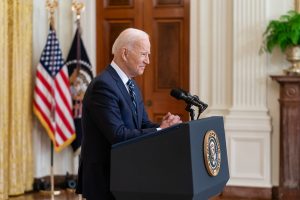This fall, the Biden administration released four important policy document reviews, providing a fresh insight into the United States’ strategic thinking. On October 12, the White House released the latest National Security Strategy (NSS) of the Biden administration. Two weeks later, on October 27, the U.S. Department of Defense jointly released the unclassified versions of three other much-anticipated policy documents: the National Defense Strategy, (NDS) the Nuclear Posture Review (NPR), and the Missile Defense Review (MDR).
Together, these documents provide an insight into the policy direction of the Biden administration which has called the current decade a “decisive” one. The latest policy approach, although based on existing security trends, has some new features that will have far-reaching impact on global security.
While emphasizing the United States’ leadership role and strengthening alliances, the new policy line has an unprecedented extensive focus on the threat from the People’s Republic of China. A U.S. “pivot to Asia” began during the Obama administration as the rise of China became a concern in the U.S. strategic thinking. However, it was during the Trump administration that China replaced Russia as a primary competitor.
A rethink of China-U.S. relations was quite visible in the subsequent official documents, such as the 2017 National Security Strategy, which asserted that China seeks to “challenge American power, influence, and interests.” Similarly, the 2018 National Defense Strategy termed Beijing a “strategic competitor” that is looking to attain “Indo-Pacific regional hegemony in the near-term and displacement of the United States to achieve global preeminence in the future.”
The Biden administration’s new strategic vision, as depicted in the recently released documents, however, has doubled down, labeling China as “America’s most consequential geopolitical challenge.” It has set the primary objective to “outcompete” Beijing in its purported regional and global objectives. By contrast, Russia, despite the ongoing war in Ukraine, is seen as a secondary threat that needs to be constrained.
The unprecedented focus on China in the U.S. policy is reflected in the Nuclear Posture Review and the Missile Defense Review. Contrary to Biden’s election promises to adopt a sole-purpose policy – declaring that the sole purpose of the U.S. nuclear arsenal is to deter adversaries – the 2022 NPR has enhanced the centrality of nuclear weapons in U.S. security policy in view of evolving threats from its adversaries. This shifting focus on the usability of nuclear weapons is likely to create an acute security dilemma in China and Russia, which in turn will ratchet up their respective capabilities. This renewed focus on nuclear weapons will further undermine U.S. security and is likely to increase the risk of inadvertent nuclear escalation.
Another associated challenge of this renewed emphasis on the centrality of nuclear weapons would be reduced desire, among all concerned parties, to engage in any future arms control agreements. While the NPR emphasizes arms control, it is unlikely to see interest and engagement from China and Russia, as they are likely to respond to the growing U.S. nuclear arsenal. There is likely to be less appetite even in the United States, which is already doubling down on its nuclear modernization plans and preparing to deal with two nuclear armed competitors.
Another worrying element is a renewed focus on not just the modernization of existing weapon systems but the development of new weapon designs. The United States has the ability to undertake that task with the help of supercomputers without violating its existing moratorium on nuclear testing; it may, however, trigger a desire for more nuclear testing in other nuclear weapons states thereby undermining the normative value of the Comprehensive Nuclear Test Ban Treaty Organization (CTBTO).
The Biden administration’s new strategy has also laid greater emphasis on integrated deterrence that transcends conventional and nuclear deterrence. According to the latest NSS, deterrence should be integrated not just across domains – including military and non-military – but also across regions, across the spectrum of conflicts, and across the range of U.S. allies and partners. On one hand, it increases the risk of entanglement; on the other, it indicates that more visible battle lines will be drawn, leaving less space for countries that want to balance their relationships and do not want to identify themselves as exclusive partners either with China or the United States, especially in the Indo-Pacific region.
This narrow view of China as a strategic competitor is likely to be a challenge for existing U.S. partners in the region whose policy objectives may not be completely in sync with U.S. objectives vis-a-vis China. For example, South Korea is seeking U.S. partnership and security primarily against the North Korean threat and it is less inclined to jeopardize its relationship with China.
Similarly, India is projected as a defense partner to deter Chinese aggression. However, India does not seem fully ready to completely toe the U.S. line on every foreign policy issue, as currently being seen in India’s stance over the Russia-Ukraine war. Despite its ongoing border issue with China and resulting embrace of the Quad, India continues to have a provocation-averse policy toward China. The United States and India have divergent priorities in the Indo-Pacific region as well; the U.S. security focus is on the South China sea, whereas India’s primary interest is pivoted more toward the Western Indian Ocean Region (WIOR). While India’s growing military capability with the help of the U.S. may not be successful in containing China, it is likely to impact regional security in South Asia. In particular, it may further destabilize the India-Pakistan dyad.
The new policy documents have set the goal to “proactively shape the international order” in a way that favors U.S. interests. The aspiration is resource-intensive and also contingent upon a network of allies and partners whose degree of willingness to fully endorse this policy may vary at the moment.
































